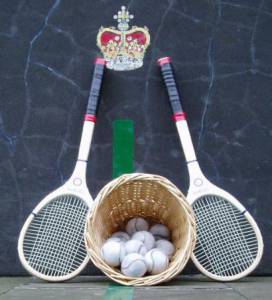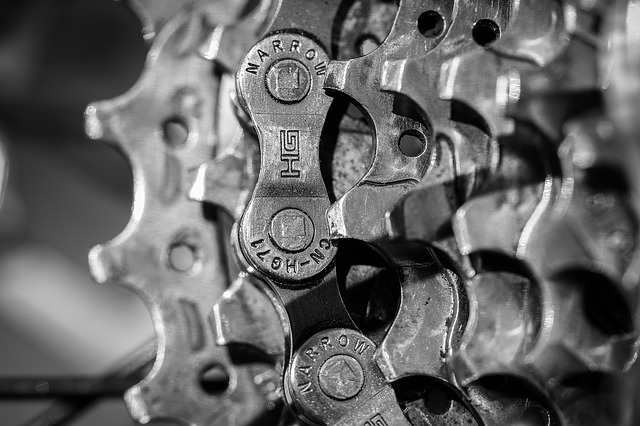During Fall 2002, Takayuki Oidemizu was a junior pursuing a major in Mechanical Engineering at the University of Southern California. Once a competitive tennis player, he now enjoys playing with his friends.
The tennis racket has experienced continuous improvements to meet the performance demands of professional players. In designing a better tennis racket, engineers and scientists need to understand exactly what happens when the ball collides with the racket. The racket frame, strings, and tennis ball experience energy transfer, resulting in deformations of all three components. With a firm grasp of the physical principles involved in the collision between the ball and racket, engineers strive to design a racket that minimizes energy loss. Accordingly, the optimization of tennis racket material and structure over the years has progressed in this vein. The original wooden rackets were followed by metal rackets, which were later replaced by composite rackets. Wide-body, oversized and long rackets improved players’ performance as well. Today’s rackets are more powerful, stronger, lighter, with improved handling – still, engineers continually seek methods to further improve tennis racket performance.
Introduction
In the game of tennis, the racket acts as an interface between the player and the ball. Tennis rackets have continuously evolved to meet the demands of a wide variety of tennis players spanning from beginners to professionals, children to adults. Power and control are two of the most important components of racket design – greater power increases the speed of a game, while greater control lends the precision to hit a winning shot.
With the continued improvement of the tennis racket, the game has progressed into a power game, especially in professional tournaments. More service aces are encountered in modern professional tennis these days, in comparison to ten years ago. Some observers criticize this fact, claiming that this results in fewer exciting rallies, causing the game to become boring. In response to these complaints, Wimbledon, the most prestigious tennis tournament, started using “deadened balls to slow play down” in 1995 – these are designed to bounce less [1]. As demand for high performance tennis rackets has grown, the role of engineers in tennis equipment design has become more prominent.
What happens when you hit the ball?
The three components in the system of ball-racket interaction are the ball, the racket frame, and the strings. During impact, all three components deform to some degree; such deformation is caused by the energy transferred amongst the three components. The ball carries kinetic energy and transfers some of it to the racket frame and strings upon impact. Some of this transferred energy is given back to the ball, allowing the ball to bounce back.
The Ball
The ball’s deformation upon impact is undesirable because “a tennis ball is required by the rules of tennis to dissipate a fraction of the energy it absorbs when it deforms against a hard surface” [2]. More specifically, a ball dropped from a height of 100 inches is required to bounce back to within 53% to 58% of its original height [3]. To minimize the energy lost by the ball’s deformation, a large fraction of energy should be absorbed by the racket frame and strings.
The Strings
Unlike the tennis ball, the strings store energy by deforming. Due to their high elasticity, the strings recover from deformation about five times more quickly than the massive racket frame, allowing a greater efficiency in returning the stored energy back to the ball – almost all of the energy stored in the strings eventually returns to the ball.
Tennis players may select a desired string tension. A lower string tension translates into greater stiffness in the string plane and greater deformation upon hitting the ball. In other words, lower tension gives the player more power. “There is, of course,” wrote Howard Brody, a professor of physics at the University of Pennsylvania, “a point of diminishing returns. After all, you can’t play tennis with a butterfly net. When the strings start moving and rubbing within the string plane, you begin to get serious energy loss” [3]. Generally, an acceptable range of tension is specified somewhere on the racket frame; as long as the string tension lies within this range, there is no need to worry about diminishing returns.
Higher tension makes for greater stability in the string plane, which also means better control. For this reason, higher string tension is often preferred by advanced players who can hit the ball hard and do not require the help of a powerful racket.
The Racket Frame
The racket frame’s mechanics during impact are similar to those of the strings. Though a racket frame appears to be quite rigid when compared to the ball and strings, it does indeed bend upon impact. Both the strings and frame return to their original shape after deformation; however, unlike the strings, the frame is significantly less elastic. According to a 1995 article by Steven Ashley, the associate editor of Mechanical Engineering, it takes about 15 to 30 milliseconds for a frame to return to its original shape. This time period may sound short, but it is too long to return the energy back to the ball, since the ball is present in the string plane for a mere three to six milliseconds – the ball leaves the racket before the racket frame has time to return in its original shape. Therefore, some energy stored in the racket frame’s deformation is lost, never returning to the ball. Consequently, engineers turned their attention towards the creation of stiffer rackets that resist deformation [4].
Tennis Racket Material Evolution
Since the introduction of the tennis racket during the 12th and 13th centuries, racket materials have progressively improved. The underlying trend of racket evolution gravitates towards lighter and stiffer materials; racket weight reduction increases the ease of use, while stiffer rackets add strength and power.
Wood
In the early history of tennis, people played with wooden rackets, typically made from ash, maple, and okume. Woods are not isotropic, meaning they do not have the same physical properties in all directions – this proved problematic, since a racket needs strength in both the vertical and horizontal axes. To overcome this problem, laminated or coated structures were introduced, adding strength and stiffness (see Fig. 1). However, racket producers had no other alternative than to add mass in response to a desire for greater stiffness – thus, a typical wooden racket weighed about 14 to 15 ounces. Such stiff and consequently heavy rackets proved unwieldy for many [2]. Additionally, classic wooden rackets had “a life expectancy of about three months of regular use” [4]. Due to these characteristics, wood was a far cry from ideal racket material.
Metal
Introduced in the late 1960s, the first metal rackets were made of steel. Steel rackets had a longer lifespan and successfully increased stiffness without adding weight. Eventually, 12.5 ounce aluminum rackets succeeded 13 ounce steel rackets. Aluminum rackets gained a reputation for better performance at a cheaper price, providing more power and control [4].
Composites
Perhaps the most significant innovation in the material technology of tennis rackets can be seen in the introduction of composite frame rackets. Legendary tennis player Arthur Ashe used a glass-fiber /aluminum /foam-core composite racket. With the continual changes in composite design since its introduction, graphite, titanium and carbon fiber rackets are most popular in the current market.
These composite rackets proved far superior to those of the past; statistically, they are 35% to 40% lighter, and twice as stiff as their wooden counterparts [4]. In addition, “tests on aluminum rackets have shown that a marked decrease in stiffness occurs at around 6,000 impacts, compared with a change in stiffness for carbon fiber rackets of around 4% after 50,000 impacts” [5].
The technology involved in composite racket design is linked to an engineering innovation. By varying the weaving pattern, engineers can design a racket whose grip region has a different stiffness from its head section. Racket weight distribution has also enhanced performance – it is now possible to shift the center of mass closer towards the tip of the racket, thereby increasing angular momentum and increasing its owner’s stroke power. Likewise, the center of mass can be shifted towards the handle for better racket handling. Thus, composite materials yield a racket that can be customized to fit the player’s needs.
Structural Advances
More than just implementing new materials, engineers today also modify the structure of tennis rackets.
Larger Frames
In 1976, Howard Head developed the oversized racket with an increased hitting surface (see Fig. 5b). “Head essentially moved the expanded hoop toward the handle without lengthening the overall frame” [4]. Bigger head area translates into longer strings in the plane, both vertically and horizontally. When longer strings collide with a ball, their scale of deformation increases because the points of support are further apart. As previously mentioned, larger deformation gives more energy to the ball. The introduction of oversized rackets caused tennis to become more of a power game.
Thicker Frames
In the late 1980s, rackets with significantly thicker frames became popular. Such enlarged frames increased the stiffness of a racket – these are often called wide-body rackets. Traditionally, the tip of a tennis racket is the most flexible part; when the ball strikes this region, a dull tingling can be felt. Wide-body rackets were designed to improve this condition, as well as to increase the overall stiffness.
However, manufacturers went to extremes when designing wide bodies. “Cross sections got wider and wider, and rackets got stiffer and stiffer” [4]. For advanced players who were accustomed to hitting the ball hard, these overly stiffened rackets behaved like rocket launchers. Players felt uncomfortable with these stiff rackets because they sacrificed control. Moreover, extremely stiff rackets were less comfortable because they absorbed little of the vibration caused by the impact. Tracy A. Leonard, a technical advisor to Tennis Magazine, said, “At the time, most manufacturers wanted the stiffest racket they could make, but there’s no question that some widebodies became too stiff” [4]. Wide-body rackets are slowly going out of style, but they are still favored by a few players for their power advantage.
Longer Rackets
Another revolution occurred in the mid 1990s. For much of the history of tennis, the standard racket length was 27 inches. When longer rackets were first introduced, people were skeptical of its effects – the concept of altering racket length was radical at the time because players were accustomed to the traditional form. Tennis superstar Michael Chang put such hesitation to rest; as one of the shortest tennis players on the men’s tennis tour at the time, he used a long racket to overcome his handicap. Upon Chang’s request, Prince, a tennis racket manufacturer, supplied the 28 inch racket to him in 1994. “Nobody noticed the difference in Chang’s model, but the change in his serve was apparent almost immediately. He went from serving 256 aces in 1993, to 366 in 1994 and 499 [in 1995]” [6].
Long rackets rapidly caught on with many tennis players, adding more speed to the ball by increasing the angular velocity of the racket head. Angular velocity is proportional to the distance between the impact point and the pivot of your swing [2]. Therefore, the longer the distance between the impact point and the pivot, the faster the ball will travel across the court. Long tennis rackets exploit this principle, thereby improving the power of many players.
Future Racket Development
Increases in power are often achieved by sacrificing control, comfort, or both. Likewise, heightened control often comes at the expense of a power decrease. Engineers attempt to optimize this delicate balance amongst power, control, and comfort to maximize racket performance. The evolution of tennis rackets has come a long way and shows no sign of slowing. The quest for an ideal racket will continue as long as there are tennis enthusiasts on the court.
References
-
- [1] S. Ashley. “A New Racket Shakes Up Tennis.” Mechanical Engineering, vol. 117, Aug. 1997, pp. 80-81.
- [2] H. Brody. “The Physics of Tennis. III. The Ball-Racket Interaction.” American Journal of Physics, vol. 65, Oct. 1997, pp. 981-987.
- [3] H. Brody. “How Would A Physicist Design A Tennis Racket?” Physics Today. vol. 48. Mar. 1995, pp. 26-31.
- [4] S. Ashley. “High-Tech Rackets Hold Court.” Mechanical Engineering, vol. 115. Aug. 1993, pp. 50-55.
- [5] M. Jenkins. “Advanced Materials Take On Tennis.” 2002. AZoMp.
- [6] D. Sparrow. “More Length, more strength (Longer Tennis Rackets Help Generate More Power).” Sports Illustrated, vol. 84 n21, Expanded Academic ASAP. InfoTrac. Salem State Coll. Lib., Salem, MA, 1996.
- [7] Museum of Tennis Production. Museum of Tennis Production. 1999.
- [8] J. Sanny and W.Moebs. University Physics. Dubuque, IA: Wm. C. Brown, 1996.






